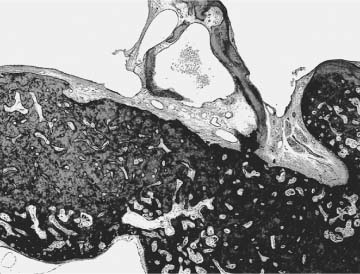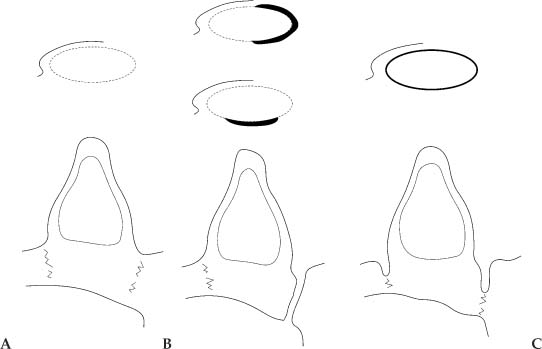Chapter 11 Obliterative otosclerosis involves total obscuration of the oval window and its margins (Fig. 11–1). It is thought to be evidence of very advanced otosclerosis. Young patients are especially at risk, particularly when active, aggressive otosclerosis develops around puberty. Obliteration of the round window is less common, and total obliteration is rare. When the round window is obliterated, however, the patient usually has an accompanying sensori-neural hearing loss. Obliterative otosclerosis can occur within the vestibule as well. Involvement of the labyrinthine vestibule and cochlea aqueduct causes the cochlea to degenerate, with accompanying profound sensorineural hearing loss. Obliterative otosclerosis is very uncommon in unilateral otosclerosis. Causse et al (1991) reported that obliterative otosclerosis is caused by the same immunoenzymatic process at work in cochlear otosclerosis. In the early stages of obliterative otosclerosis, thin osteoid lamellae are found in the deep part of the highly vascularized mucoperiosteum of the fissula ante fenestram. Once the disease advances, however, the stapes superstructure and its crura are eventually buried in the extension of otosclerotic bone that fills the oval window niche. Bone thickness in the obliterated oval window niche varies from 0.5 mm to more than 2.0 mm (Gristwood 1966). Early attempts to drill out the obliterated footplate were accompanied by severe sensorineural hearing loss (Guilford 1963). Reclosure of the drilled-away footplate was reported in 50% of cases by House (1962). Some authors (e.g., Cody et al 1967) even considered the obliterated footplate as a reason to abandon stapedectomy. Gristwood (1966) reported a 12.5% incidence of obliterated footplates in his series, noting that cases of obliterative otosclerosis were almost invariably diagnosed during adolescence and were associated with the presence of aggressive disease. He found it impossible to predict before surgery on the basis of audiometry and clinical findings that an obliterated footplate awaited the surgeon. Gristwood attributed the high incidence of obliterated foot-plates in his series to the low levels of sodium fluoride in drinking water. It is interesting to note that all authors agree that obliterated footplates are found in adolescents and young adults usually at puberty, between the ages of 12 and 15 years. Gristwood and Venables (1983) reported that they found no strong evidence that pregnancy increases the progression of obliterative otosclerosis. Figure 11–1 Photomicrograph of an obliterated foot-plate. Other authors (Farrior 1981; Gristwood and Venables 1975; Shambaugh 1963) have quoted an incidence of obliterative otosclerosis ranging from 7 to 11% in their series. Amedee and Lewis (1987), however, quoted a figure of 20% in their series. Hurtado Garcia and colleagues (1995) reported a figure of 6.2% in their series. Ayache et al (1999) reported an incidence of 4.7% in their series and noted that there was a 50% chance that obliterative otosclerosis would be a bilateral finding. Raman et al (1991) reported the following in their analysis of 420 consecutive cases of obliterative otosclerosis. The proportion of truly obliterated cases was 33.09%. The male to female ratio was 1.48 males per 1.0 female. In the nonobliterated cases, the ratio of male to female was 1.34:1.00. The mean age at onset was 19.14 years; in the nonobliterated cases, it was 25.60. This was found to be statistically significant (p >.001). In the nonobliterated cases, the age at onset was 30.86 and was not found to be as statistically significant. In the case of a truly obliterated footplate, the footplate is thickened and is later replaced by a massive otosclerotic focus (Fig. 11–2A). The boundaries of the footplate cannot be identified, and there is no delineation present to indicate the margins of the footplate. The crura of the footplate are covered and sometimes buried by the massive otosclerotic focus. The otosclerotic bone may be up to 2.5 mm thick. Figure 11–2 Schematic representation of an obliterated footplate. (A) The footplate (dotted lines) is truly obliterated and cannot be distinguished from the surrounding bone. (B) The footplate is partly obliterated with a line of delineation (dark lines). (C) Spuriously obliterated footplate. The dark lines indicate apparent delineation of the footplate. (From Beales PH. Otosclerosis. Bristol: John Wright and Sons; 1981. Used with permission.) A partly obliterated footplate occurs in approximately 4.6% of cases. The footplate is diffusely thickened; however, a rim of delineation can be identified (the rim may not be completely identifiable in the entire dimension of the footplate) (Fig. 11–2B). The incidence of a spuriously obliterated footplate (Fig. 11–2C) is approximately 0.5%. In this situation, a surrounding rim is seen in the presence of a solid, thick footplate. It only becomes clear that the delineation is false when the surgeon tries to remove the footplate and fails because the footplate is thicker than anticipated. The biscuit, or “rice grain,” footplate is diffusely thickened, while retaining a clear, well-delineated rim and an intact annular ligament. The surgeon should operate with caution in these situations, for it is easy for this kind of footplate to become dislodged. In a crowded oval window niche, the oval window is crowded by the oto-sclerotic focus. A slitlike opening is all that is seen. The footplate, however, may be relatively thinner than a truly obliterated footplate. The overhanging bone should be removed with care before addressing the footplate. As stated earlier, it is rare for the round window to be obliterated completely. It is not uncommon, however, to find the round window narrowed. Following the oval window, the round window is the second most common site at which otosclerosis occurs. The incidence of round window obliteration ranges from about 0.5 to 1.0%, as reported in the literature (Ginsberg et al 1978; Shea and Farrior 1987), although Causse et al (1991) reported that round window obliteration occurs only in approximately 1 in 250 cases. Preoperatively early onset of hearing loss, either in childhood or in adolescence, and a strong family history of otosclerosis are usually associated with obliteration of the round window.
Obliterative Otosclerosis
PATHOLOGY
INCIDENCE
TYPES OF OBLITERATED FOOTPLATES
Truly Obliterated Footplate
Partly Obliterated Footplate
Spuriously Obliterated Footplate
Biscuit Footplate
Crowded Oval Window Niche
ROUND WINDOW OBLITERATION
Stay updated, free articles. Join our Telegram channel

Full access? Get Clinical Tree




